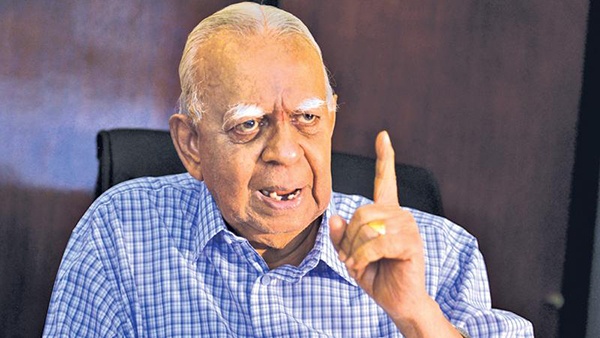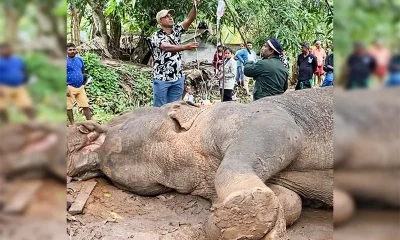News
TNA renews calls for foreign mechanism

… says its constitutional proposals ready
By Dinasena Rathugamage
TNA leader MP R. Sampanthan has said his colaition will not be accepting a homegrown solution to what he calls the national problem. Instead, a solution should be found with the participation of the international community. That will be the main condition in the TNA’s proposal for a new constitution to be submitted to the government.
MP Sampanthan said so at the TNA’s final meeting on Monday in Colombo to decide on the content of the draft proposal to be submitted.
Representatives of the ITAK, TELO and PLOTE were present at the meeting.
The TNA’s draft proposal was a 21-page document containing certain aspects on the basis of provisions of the 13th Amendment to the Constitution, sources said.
MP Sampanthan requested his party colleagues not to publish the details of the content of their draft proposal until the government responded to them.
However, the other TNA MPs said that the draft proposals contained suggestions to formulate new laws pertaining to certain aspects such as education, law, land tenure, health, agriculture and irrigation in the
Northern and Eastern Provinces and they also prepared translations of the proposals in English and Sinhala so that it would be available in all three languages.
News
Financial contributions received for ‘Rebuilding Sri Lanka’ Fund

The Government’s ‘Rebuilding Sri Lanka’ Fund, established to provide relief and support to communities affected by Cyclone Ditwah, continues to receive financial contributions on a daily basis.
Accordingly, the Containers Transport Owners Association made a financial contribution of Rs. 1.5 million, while the Association of SriLankan Airlines Licensed Aircraft Engineers contributed Rs. 1.35 million to the Fund.
The respective cheques were formally presented to the Secretary to the President, Dr. Nandika Sanath Kumanayake, at the Presidential Secretariat on Friday (19).
The occasion was attended by W. M. S. K. Manjula, Chairman of the Containers Transport Owners Association, together with Dilip Nihal Anslem Perera and Jayantha Karunadhipathi.
Representing the Association of SriLankan Airlines Licensed Aircraft Engineers were Deshan Rajapaksa, Samudika Perera and Devshan Rodrigo handed over the cheque.
News
UNICEF representatives and PM discuss rebuilding schools affected by the Disaster

A meeting between Prime Minister Dr. Harini Amarasuriya and a delegation of UNICEF representatives was held on Saturday, (December 20) at the Prime Minister’s Office.
During the meeting, the Prime Minister explained the measures taken by the Government to ensure the protection of the affected student community and to restore the damaged school system, as well as the challenges encountered in this process.
The Prime Minister stated that reopening schools located in landslide-prone areas would be extremely dangerous. Accordingly, the Government is focusing on identifying such schools and relocating them to suitable locations based on scientific assessments.
The Prime Minister further noted that financial assistance has been provided to students affected by the disaster, enabling parents to send their children back to school without an additional financial burden. Emphasizing that school is the safest place for children after their homes, the Prime Minister expressed confidence that the school environment would help restore and improve students’ mental well-being
The Prime Minister also highlighted that attention has been given to several key areas, including the relocation of disaster-affected schools, restoration of school infrastructure, merging and operating certain schools jointly, facilitating teaching and learning through digital and technological strategies, and providing special transportation facilities. She emphasized that the Government is examining these issues and is committed to finding long-term solutions.
The UNICEF representatives commended the Government’s commitment and the initiatives undertaken to restore the education sector and assured their support to the Government. Both parties also discussed working together collaboratively on future initiatives.
The meeting was attended by the UNICEF representatives to Sri Lanka Emma Brigham, Lakshmi Sureshkumar, Nishantha Subash, and Yashinka Jayasinghe, along with Secretary to the Ministry of Education Nalaka Kaluwewa, Director of Education Dakshina Kasturiarachchi, Deputy Directors Kasun Gunarathne and Udara Dikkumbura.
(Prime Minister’s Media Division)
News
NMRA laboratory lacks SLAB accreditation

Drug controversy:
“Setting up state-of-the-art drug testing facility will cost Rs 5 billion”
Activists call for legal action against politicians, bureaucrats
Serious questions have been raised over Sri Lanka’s drug regulatory system following revelations that the National Medicines Regulatory Authority’s (NMRA) quality control laboratory is not accredited by the Sri Lanka Accreditation Board (SLAB), casting doubt on both the reliability of local test results and the adequacy of oversight of imported medicines.
Medical and civil rights groups warn that the issue points to a systemic regulatory failure rather than an isolated lapse, with potential political and financial consequences for the State.
Chairman of the Federation of Medical and Civil Rights Professional Associations, Specialist Dr. Chamal Sanjeewa, said the controversy surrounding the Ondansetron injection, which was later found to be contaminated, had exposed deep weaknesses in drug regulation and quality assurance.
Dr. Sanjeewa said that the manufacturer had confirmed that the drug had been imported into Sri Lanka on four occasions this year, despite later being temporarily withdrawn from use. The drug was manufactured in India in November 2024 and in May and August 2025, and imported to Sri Lanka in February, July and September. On each occasion, 67,600 phials were procured.
Dr. Sanjeewa said the company had informed the NMRA that the drug was tested in Indian laboratories, prior to shipment, and passed all required quality checks. The manufacturer reportedly tested the injections against 10 parameters, including basic quality standards,
pH value, visual appearance, component composition, quantity per phial, sterility levels, presence of other substances, bacterial toxin levels and spectral variations.
According to documents submitted to the NMRA, no bacterial toxins were detected in the original samples, and the reported toxin levels were within European safety limits of less than 9.9 international units per milligram.
Dr. Sanjeewa said the credibility of local regulatory oversight had come under scrutiny, noting that the NMRA’s quality control laboratory was not SLAB-accredited. He said establishing a fully equipped, internationally accredited laboratory would cost nearly Rs. 5 billion.
He warned that the failure to invest in such a facility could have grave consequences, including continued loss of life due to substandard medicines and the inability of the State to recover large sums of public funds paid to pharmaceutical companies for defective drugs.
“If urgent steps are not taken, public money will continue to be lost and accountability will remain elusive,” Dr. Sanjeewa said.
He added that if it was ultimately confirmed that the drug did not contain bacterial toxins at the time it entered Sri Lanka, the fallout would be even more damaging, severely undermining the credibility of the country’s health system and exposing weaknesses in health administration.
Dr. Sanjeewa said public trust in the health sector had already been eroded and called for legal action against all politicians and public officials responsible for regulatory failures linked to the incident.
by Chaminda Silva ✍️
-

 Midweek Review6 days ago
Midweek Review6 days agoHow massive Akuregoda defence complex was built with proceeds from sale of Galle Face land to Shangri-La
-

 News5 days ago
News5 days agoPope fires broadside: ‘The Holy See won’t be a silent bystander to the grave disparities, injustices, and fundamental human rights violations’
-

 News5 days ago
News5 days agoPakistan hands over 200 tonnes of humanitarian aid to Lanka
-

 Business4 days ago
Business4 days agoUnlocking Sri Lanka’s hidden wealth: A $2 billion mineral opportunity awaits
-

 News6 days ago
News6 days agoBurnt elephant dies after delayed rescue; activists demand arrests
-

 Editorial6 days ago
Editorial6 days agoColombo Port facing strategic neglect
-

 News4 days ago
News4 days agoArmy engineers set up new Nayaru emergency bridge
-

 News6 days ago
News6 days agoSri Lanka, Romania discuss illegal recruitment, etc.



















